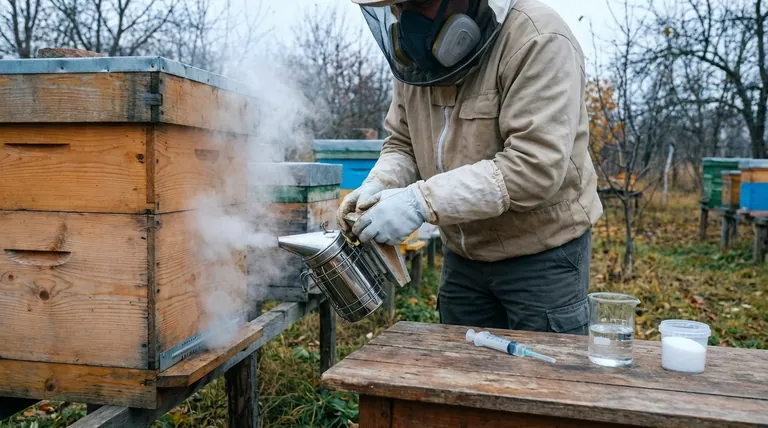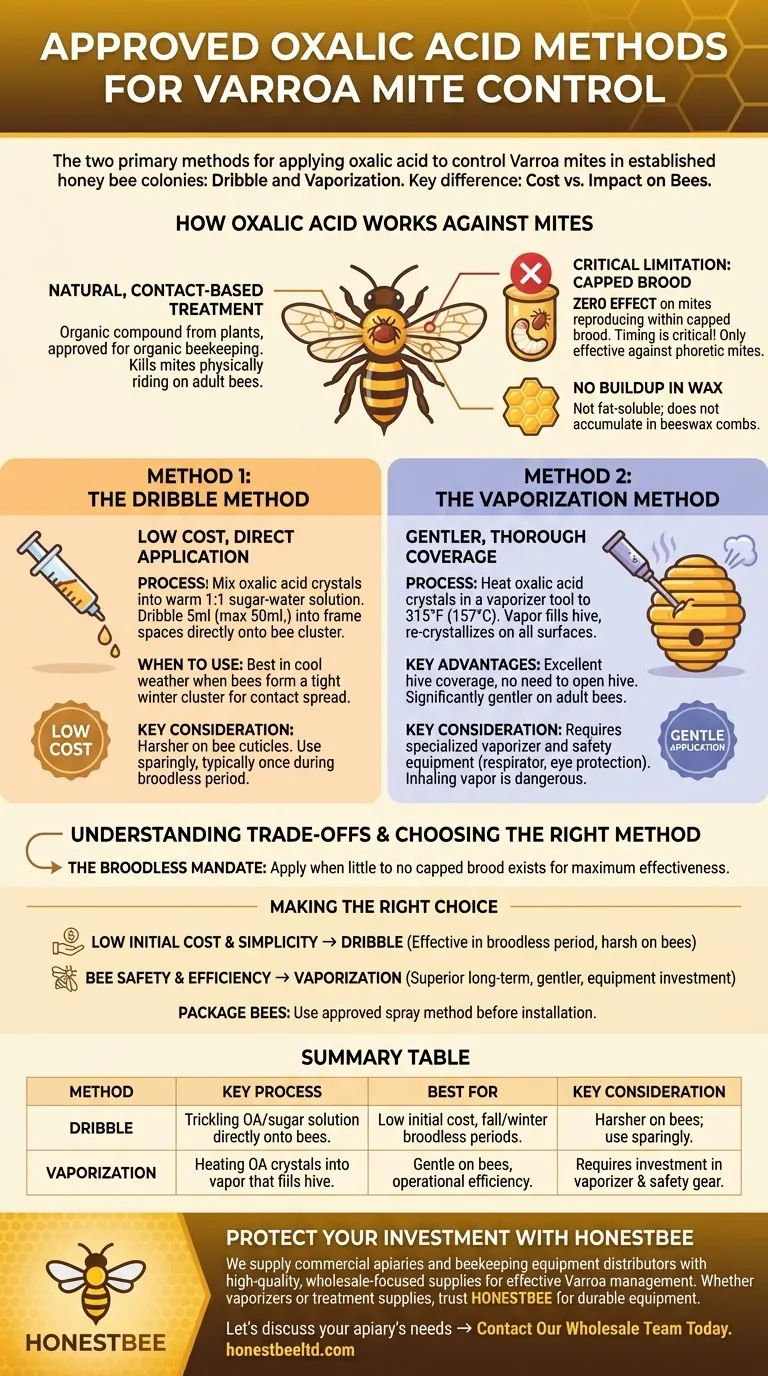The two primary approved methods for applying oxalic acid to control Varroa mites in an established honey bee colony are the dribble method and the vaporization method. The dribble method involves trickling a solution of oxalic acid and sugar water over the bees, while vaporization uses a specialized tool to heat oxalic acid crystals into a vapor that permeates the hive.
The core difference lies in a trade-off between cost and impact on the bees. The dribble method is inexpensive but harder on the colony, whereas vaporization is gentler on the bees but requires an investment in specialized equipment.

How Oxalic Acid Works Against Mites
To use oxalic acid effectively, it's crucial to understand its mechanism and limitations. It is a powerful tool, but only when applied under the right conditions.
A Natural, Contact-Based Treatment
Oxalic acid is an organic compound found naturally in many plants, including spinach and rhubarb. It is approved for use in organic beekeeping.
Its mode of action is topical; it kills Varroa mites that are physically riding on adult bees. The acid is absorbed through the mite's soft pads on their feet, proving fatal.
The Critical Limitation: Capped Brood
Oxalic acid's primary weakness is its inability to penetrate the wax cappings of brood cells. This means it has zero effect on mites reproducing within capped brood.
Therefore, any treatment is only effective against "phoretic" mites—those attached to adult bees. This makes timing the single most important factor for success.
No Buildup in Wax
A significant advantage of oxalic acid is that it is not fat-soluble. Unlike some synthetic miticides, it does not accumulate in the beeswax of the combs, reducing the risk of contamination over time.
Method 1: The Dribble Method
The dribble method is a low-cost approach that uses a simple solution applied directly to the bees.
The Process
This method involves mixing oxalic acid dihydrate crystals into a warm 1:1 sugar-water solution. The mixture is then drawn into a large syringe.
The beekeeper applies a small, measured amount of the solution (typically 5ml) into the spaces between the frames, dribbling it directly onto the bees clustered there. A typical maximum dose is 50ml per colony.
When to Use It
The dribble method is most effective in cool weather when the bees have formed a tight winter cluster. This ensures the bees are in close contact, allowing the solution to spread from bee to bee throughout the colony.
Key Considerations
This method is known to be harsh on the bees' exoskeletons (cuticles). For this reason, it should be used sparingly, often only once during the late fall or early winter broodless period.
Method 2: The Vaporization Method
Vaporization, also known as sublimation, is considered by many to be a gentler and more thorough application method.
The Process
This technique requires a specialized tool called an oxalic acid vaporizer. A measured dose of oxalic acid crystals is placed into the vaporizer, which is then inserted into the hive entrance.
The vaporizer heats the crystals to about 315°F (157°C), causing them to sublimate directly from a solid into a gas. This vapor fills the hive cavity and then re-crystalizes on all surfaces, including the bees and mites.
Key Advantages
Vaporization provides excellent coverage throughout the hive without the need to open it, minimizing disturbance to the colony. It is widely considered to be significantly gentler on the adult bees than the dribble solution.
Equipment and Safety
The primary downside is the need for the vaporizer tool and essential safety equipment. The beekeeper must wear a properly rated respirator mask and eye protection, as inhaling the vapor is extremely dangerous to human health.
Understanding the Trade-offs
Neither method is universally superior; the correct choice depends on your goals, equipment, and hive conditions. The most crucial factor for either method is timing.
The Broodless Mandate
For maximum effectiveness, oxalic acid must be applied when the colony has little to no capped brood. Treating a hive with a large amount of brood will fail to eliminate the majority of mites, which are safely reproducing under the cappings. This typically restricts its use to the late fall or early winter.
A Note on Package Bees
A third, more niche application is the spray method. This is specifically labeled for use on package bees before they are installed in a hive. A light sugar-water and oxalic acid solution is sprayed directly onto the caged bees, taking advantage of the completely broodless state of a new package.
Making the Right Choice for Your Apiary
Your decision should be guided by a clear assessment of your budget, long-term goals, and commitment to bee health.
- If your primary focus is low initial cost and simplicity: The dribble method is effective when performed correctly during a true broodless period, but be mindful of its harshness on the bees.
- If your primary focus is bee safety and operational efficiency: Investing in a vaporizer is the superior long-term choice, as it is gentler on the colony and allows for treatment without opening the hive.
- If you are installing new package bees: The approved spray method is the designated protocol for treating them effectively before they begin raising brood.
Ultimately, using oxalic acid responsibly is about applying the right tool at precisely the right time to protect your colonies with minimal harm.
Summary Table:
| Method | Key Process | Best For | Key Consideration |
|---|---|---|---|
| Dribble | Trickling an OA/sugar solution directly onto bees. | Low initial cost, fall/winter broodless periods. | Harsher on bees; use sparingly. |
| Vaporization | Heating OA crystals into a vapor that fills the hive. | Gentle on bees, operational efficiency. | Requires investment in a vaporizer and safety gear. |
Protect Your Investment with the Right Equipment
Choosing the correct mite control method is essential for the health of your apiary and the success of your season. At HONESTBEE, we supply commercial apiaries and beekeeping equipment distributors with the high-quality, wholesale-focused supplies needed for effective Varroa management.
Whether you are standardizing your operation with reliable vaporizers or stocking up on essential treatment supplies, we provide the durable equipment that commercial beekeepers trust.
Let's discuss your apiary's needs → Contact Our Wholesale Team Today
Visual Guide

Related Products
- Durable 12V Oxalic Acid Vaporizer for Varroa Mite Treatment Beehive Beekeeping Tool
- Oxalic Acid Vaporizer 12V for Bee Varroa Mite Treatment
- 12V Bee Mite Removal Evaporator Oxalic Acid Vaporizer for Bee Fumigation Treatment 180W Atomization
- Adjustable Formic and Acetic Acid Dispenser for Bee Mite Treatment
- Professional Bamboo Queen Isolation Cage
People Also Ask
- What is the role of oxalic acid in plants? A Key to Plant Defense and Internal Regulation
- Can oxalic acid vaporization be used with honey supers on the hive? Ensure Legal Compliance & Honey Safety
- What is the most common method of applying oxalic acid for mite control? Dribble vs. Vaporization for Varroa
- What should be done after applying the vapor? A Step-by-Step Guide to Sealing Your Hive
- What are the key considerations when choosing between the dribble and vaporization methods? Master Hive Treatment for Any Season



















